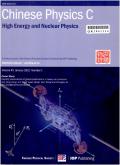Quasi-normal modes, Emission rate and Shadow of the charged AdS black hole with perfect fluid dark matter
IF 3.6
2区 物理与天体物理
Q1 PHYSICS, NUCLEAR
引用次数: 0
Abstract
In this work we investigate a comprehensive examination of a charged AdS black hole surrounded by a distinct form of dark matter, focusing on key elements including the Hawking temperature, quasi-normal modes, emission rate, and the shadow. Our investigation commences by computing the Hawking temperature, thereby identifying critical values such as the black hole's critical radius and maximum temperature, essential in delineating its phase transition. Further exploration centers on the analysis of quasi-normal modes in charged AdS black holes immersed in perfect fluid dark matter (PFDM) within the massless scalar field paradigm. Employing the Wentzel-Kramers-Brillouin (WKB) method, we accurately derive the frequencies of these black hole quasi-normal modes (QNMs). Additionally, we conduct a meticulous assessment of how the intensity of the PFDM parameter $\alpha$ influences the partial absorption cross sections of the black hole, along with a detailed study of the energy emission rate's frequency variation. The pivotal role of geodesics in understanding astrophysical black hole characteristics is highlighted. Specifically, our investigation examines the influence of the dark matter parameter on photon evolution by computing the black hole's shadow radius. Our findings distinctly demonstrate the significant impact of the PFDM parameter $\alpha$ on the boundaries of the black hole's shadow, unveiling crucial insights into its features and interactions. This comprehensive analysis provides profound insights into the intricate dynamics between a charged AdS black hole, novel dark matter, and various physical phenomena, illuminating their interplay and contributing valuable knowledge to the understanding of these cosmic entities.带有完美流体暗物质的带电 AdS 黑洞的准正常模式、发射率和阴影
在这项工作中,我们对被一种独特形式的暗物质包围的带电 AdS 黑洞进行了全面研究,重点是霍金温度、准正常模式、发射率和阴影等关键要素。我们的研究从计算霍金温度开始,从而确定黑洞的临界半径和最高温度等临界值,这对划分黑洞的相变至关重要。进一步的探索集中于在无质量标量场范式中分析浸没在完美流体暗物质(PFDM)中的带电 AdS 黑洞的准正常模式。我们采用文采尔-克拉默-布里渊(WKB)方法,精确地推导出了这些黑洞准正常模式(QNMs)的频率。此外,我们还细致评估了 PFDM 参数 $\alpha$ 的强度如何影响黑洞的部分吸收截面,并详细研究了能量发射率的频率变化。大地测量学在理解天体物理黑洞特征方面的关键作用得到了强调。具体来说,我们的研究通过计算黑洞的阴影半径来检验暗物质参数对光子演化的影响。我们的研究结果清楚地表明了PFDM参数$\alpha$对黑洞阴影边界的重大影响,揭示了黑洞特征和相互作用的重要见解。这一全面分析深刻揭示了带电AdS黑洞、新型暗物质和各种物理现象之间错综复杂的动力学关系,阐明了它们之间的相互作用,为理解这些宇宙实体贡献了宝贵的知识。
本文章由计算机程序翻译,如有差异,请以英文原文为准。
求助全文
约1分钟内获得全文
求助全文
来源期刊

中国物理C
物理-物理:核物理
CiteScore
6.50
自引率
8.30%
发文量
8976
审稿时长
1.3 months
期刊介绍:
Chinese Physics C covers the latest developments and achievements in the theory, experiment and applications of:
Particle physics;
Nuclear physics;
Particle and nuclear astrophysics;
Cosmology;
Accelerator physics.
The journal publishes original research papers, letters and reviews. The Letters section covers short reports on the latest important scientific results, published as quickly as possible. Such breakthrough research articles are a high priority for publication.
The Editorial Board is composed of about fifty distinguished physicists, who are responsible for the review of submitted papers and who ensure the scientific quality of the journal.
The journal has been awarded the Chinese Academy of Sciences ‘Excellent Journal’ award multiple times, and is recognized as one of China''s top one hundred key scientific periodicals by the General Administration of News and Publications.
 求助内容:
求助内容: 应助结果提醒方式:
应助结果提醒方式:


